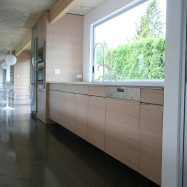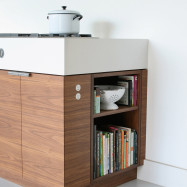MADE, Inc.
MADE, Inc.
A truth seeker who switched from philosophy to cabinetry.
Bo Hagood moved to Portland with a degree in philosophy. Not wanting to become a professor he enrolled in a night class at the Oregon College of Art and Craft and had a real epiphany: that he was going to become a woodworker. This culminated in the opening of MADE in 2000.
MADE designs and builds furniture and cabinetry that is, at once, sparingly modern and yet relaxed and friendly. The look is simple and clean, yet their use of materials is lush and rich. These folks make wood sing. They have mastered what some refer to as American Modern: expanses of clean, flush surfaces and materials that are inherently warm and decorative. Walnut and white oak are perennial favorites in this shop as they love woods with strong horizontal grains. “We put material at the forefront and really celebrate it. We are so picky about materials we even prefer to do our own veneering.”
“I am interested in creating new—not just regenerating what we have seen before,” explains Bo Hagood. “My design philosophy was formed by the process of learning how to make things. I spent a year learning how to make joinery and use machine tools before I designed a single piece. So when I design I don’t just think about how something is going to look, I think about how all of the pieces are going to come together. It is this kind of problem solving that informs everything we do.”
This “problem solving” includes a fiendish attention to detail. “We are perfectionists.” explains Hagood. “I enjoy the process of taking things to the 100% mark.” Doors and drawers are meticulously mitered so the wood grain perfectly wraps around corners without breaking the continuous grain. The sides of the cabinets are just as attractive (and important) as the faces. This studio as also really considered the user experience; deep drawers are compartmentalized with dividers to keep items neat and within reach. Another shop specialty is the way they have incorporated the electrical outlet within the wood veneer. It is almost completely hidden except for the actual round plug socket.
MADE’s unique style has won the hearts of many of today’s elite design cognoscenti. Their projects have been included in the über cool Alex Calderwood’s Ace Hotel. Retailers ranging from Stumptown Coffee Roasters to the apparel retailer Li Ning have used them to design and build their interiors. They even outfitted the Portland headquarters of the modern furniture and design retailers Hive Modern.
MADE has developed a ready-made standard cabinet line that is specific to their aesthetic and style. “This way we can ship cabinets all over the country without having to be on-site to install them ourselves. We have developed a simple system that any contractor could install.”
But let us not forget that all this good design hails from Portland; the greenest city in America. How does MADE rate in this respect? Their environmental ethics are as exacting as their designs. Hagood explains “As woodworkers it is easy for us to respect sustainability because by working in wood we are already indebt to the environment around us. This is why we choose to make heirloom pieces that will last and be cherished for generations.”
Hagood switched to PureBond® plywood with formaldehyde-free technology as soon as he learned about it in 2005. He tells this story “Years ago I worked in someone else’s shop where cabinets were made with MDF. We wore respirators and despite this I would have a headache and feel nauseated at the end of each day. I wondered what kind of toll this was taking on my brain? PureBond gave me an opportunity to get away from formaldehyde for myself, my employees, and my clients.”
These folks don’t just nod to sustainability; it is a complete lifestyle for them. This shop, in keeping with the Portland ethos, prides itself on what little waste they generate. “Our wood sawdust gets picked up once a week and used by food composters as an additive to keep decomposing food from becoming a gelatinous mess. We put out our wood scrap waste every other week and it is collected and turned into mulch. We generate so little garbage that it gets picked up once a month and we share that with our neighbor – so very little goes into the landfill! We have 5 people working here and four of us bike to work.”




















